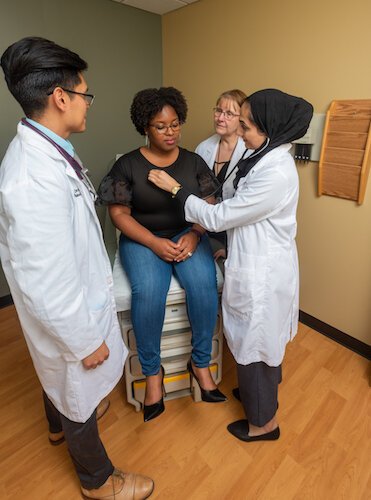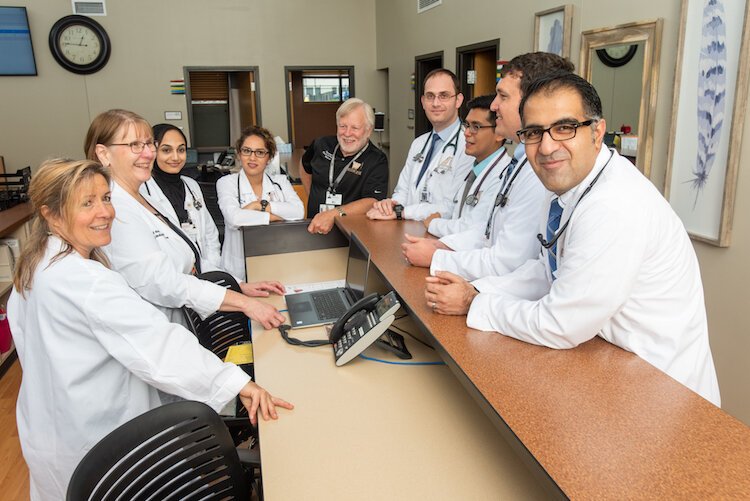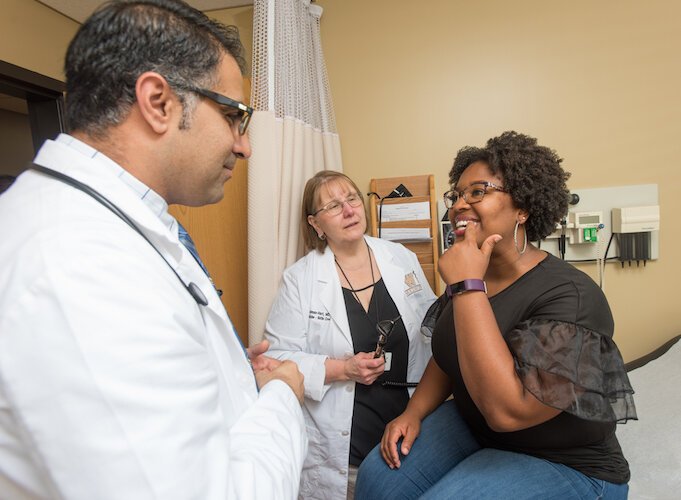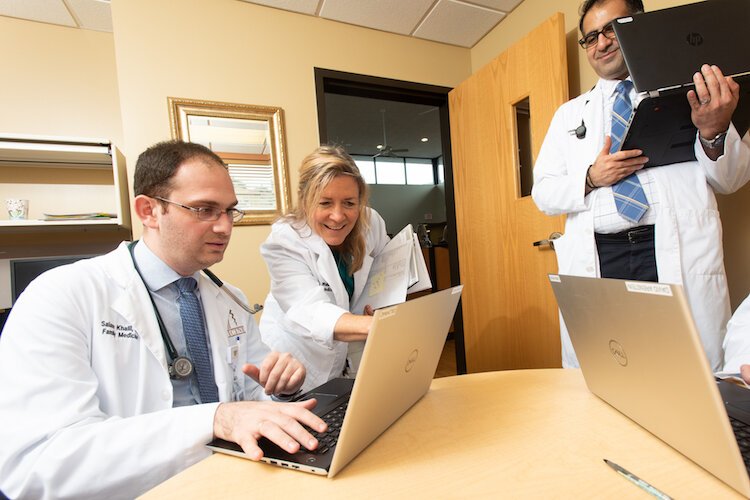Battle Creek’s Grace Health goes beyond the standard doctor’s visit with collaborations and teamwork
Grace Health in Battle Creek is committed to helping those who can't afford to get medical care elsewhere. That's one reason it has a Family Medicine emphasis and lots of services including OB-GYN, optometry, and behavioral health, in addition to an on-site pharmacy and other wraparound services.
Editor’s note: This story is part of Southwest Michigan Second Wave’s On the Ground Battle Creek series.
Not long ago the leadership of Grace Health made the decision to stop taking patients with private insurance so they can make sure that those patients on Medicare, Medicaid or with no insurance are able to get the care they need.
Looked at strictly from a dollars and cents perspective, this 2018 decision might not have appeared to be a great business move, but leaders of the medical facility on Emmett Street in Battle Creek say they have a mission to serve an underserved patient population and meet unmet needs.
Of the 32,000 patients seen in 2019 at Grace Health, 57 percent are on Medicaid; 6.6 percent are on Medicare; 20.6 percent are on private insurance (those who were grandfathered in before the decision to stop accepting patients with private insurance); and 16 percent have no insurance, says Dr. Sheng Liu, Vice President and Chief Medical Officer for Grace Health.
Liu says other medical facilities and hospitals have a strong preference for taking on patients who have private insurance and this makes it difficult for the population with Medicaid to get care through these healthcare providers.
“Grace Health is trying to fill the gap for those needs,” Liu says. “A lot of private practices won’t take Medicaid. If a patient has no ability to pay we find the money. It’s not like it’s free, but we do offer very deeply discounted medical services. Our patients pay whatever they are able to pay.”
“Most of what we make is what we bill,” says Dr. Holli K. Neiman-Hart, Associate Professor of Family and Community Medicine with WMed (Western Michigan University Homer Stryker M.D. School of Medicine) and Program Director, Family Medicine Residency – Battle Creek. “We have an abundance of grants and other programs that make it cost-effective.”
Grace Health began 34 years ago as a small clinic. Liu says its growth was small until 1992 when the health clinic got into a Federally Qualified Health Center model. FQHC’s are community-based health care providers that receive funds from the Health Resources and Services Administration Health Center Program to provide primary care services in underserved areas. It is the only FQHC in Calhoun County.
Liu says the HRSA funding enabled Grace Health to develop and provide more services. “We are the main provider of services outside of the hospital to Battle Creek residents,” Liu says. “We focus on whatever the needs are in the community.”
In April 2018, the Accreditation Council for Graduate Medical Education (ACGME) approved a new Family Medicine Residency Program at Bronson Battle Creek. The partnership then expanded to include Grace Health.
Hypertension, diabetes, COPD, asthma, infectious diseases, and cellulitis top the list of medical issues being experienced by patients at Grace Health.
Neiman-Hart says, “We have very complex patients who may have three or four of those” medical issues.
“Medicare patients tend to have more complex medical histories because they wait too long before coming in for medical care,” Liu says. “At Grace Health a lot of time is spent trying to take care of patients before they get to that point.”
Neiman-Hart says, “The collaboration with WMed, Bronson Battle Creek, and Grace Health strengthens the shared commitment to providing health care to the underserved people in our community by providing quality, comprehensive care for all ages. This was a pivotal step in our work to enrich this community and improve the quality of life for our patients who call Battle Creek and Calhoun County home.”
The first class of resident physicians began their training this summer, splitting their time between caring for patients at Grace Health and Bronson Battle Creek. The residents say this provides a much-needed continuum of care for their patients.
“When a patient gets discharged from Bronson, I can continue to see them in my office at Grace Health,” says Dr. Christian Ordaz, a Grace health resident who came to Battle Creek from the Philadelphia College of Osteopathic Medicine. “This is good for the continuity of care.”
He says that one of his favorite things about being at Grace Health is the number of resources available to him and his patients. A patient may initially come in for “one small thing” but during the course of that visit, Ordaz may see that he or she is in need of other medical services, including mental health services.
“I recognize that a patient may need something that I can’t give them in a 20-minute appointment and I can send them to someone else,” Ordaz says.
In addition to its Family Medicine emphasis, Grace Health also offers services, including OB-GYN, optometry, and behavioral health, in addition to an on-site pharmacy and other wraparound services. Patients can find dental services, physical therapy, podiatry and pediatric care, too.
A walk-in clinic that is open during morning hours and from 4 to 7 p.m. Monday through Friday has been a significant enhancement for primary care, Liu says, adding that it’s been especially helpful for parents with sick children who may get sent home from school with a variety of illnesses.
Liu says the clinic also has helped to decrease the “no show” rate for doctor appointments that went from 22 percent to 14 percent.
“We have a group of patients and sometimes it’s difficult to get them in here and they often don’t understand exactly what we’re trying to do,” Neiman-Hart says. “We ask a lot of our patients and ask them to take a lot of medications they may not be familiar with and do things they may not want to do.”
At Grace Health, patients have access to residents and faculty physicians who will provide them with high-quality medical care offered in a team-based approach.
The various areas of medical specialty are assembled in a “neighborhood” model at Grace Health where the building is sectioned off into three different areas of care or “neighborhoods.” The physicians meet with one another to talk about the medical issues their patients are dealing with. Nieman-Hart says this enables the health center to put patients with providers who have knowledge of their medical needs if the physician they normally see isn’t available.
Neighborhoods A and B provide a broad spectrum of care with family medicine and internal medicine providers in those neighborhoods and Neighborhood C is a medical floor for the residency program.
Liu says those who care for patients are part of a team. “If a patient of mine lands in the same neighborhood as Dr. Nieman-Hart and I am not available, she will already know this patient and she already has a good amount of information about this patient,” Liu says. “This is the value of that continuity of care. She will feel more comfortable because she’ll already know this patient and their history. There is a relationship between the patient and provider.”
Neiman-Hart says this team-based approach was borne out of necessity because everyone at Grace Health wears different hats.
“We have a large cohort of nurse practitioners and physician’s assistants and many of them have other jobs,” she says. “Functionally, a lot of our providers are part-time and it’s important that we work as a team.”
Another outgrowth of this team-based approach is a Centering Pregnancy and Parenting program that offers resources for women and their spouses, partners or significant others during and after their pregnancies.
A group of patients with similar due dates gets together to share resources and receive peer-to-peer support. During this time they also meet with their health-care provider for one-on-one individual examinations and they also have access to nutritionists and behavioral specialists.
Towards the end of their pregnancy, they move from monthly to twice monthly group meetings. Once they deliver they have the opportunity to participate in parenting classes with other new parents.
Neiman-Hart says they will have an appointment during a certain time of the day with an average of three other moms and their babies. During this time the babies get weighed, measured, examined, and get all of their shots done in one visit. They also have interaction with trained group leaders who will offer them parenting tips, including the best sleeping position for a baby or how to care for a colicky baby.
Dr. Lubbin Bhagat, a Grace Health resident who did her clinical training in Chicago, says having specialists such as social workers and nutritionists on-site enables her to offer her patients more options.
“It makes coming to work easier because we’re able to have all this access,” Bhagat says. “If I don’t know who to contact, someone else will.”
The residents began their training with a load of between four and five patients. Those numbers have increased by more than half.
But, Grace Health resident Hesam Shakourianfard says if more people knew of the services provided there he and his fellow residents could do even more.
“We could offer a lot of services for patients so that they don’t have to go to the emergency room,” says Shakourianfard who did his clinical training in Houston. “They could get a continuum of care that E.R. and hospital visits can’t offer. We are able to develop relationships with patients. We understand what they like and don’t like and what their real needs are.
“A lot of people don’t know what family physicians do.”
Ordaz says the scope of Family Medicine is very broad and in many cases eliminates the need to seek care at a hospital or in an emergency room. “Lots of the issues they are seen for in the E.R. or a hospital could very well be addressed as an outpatient,” Shakourianfard says. “They would be saving a lot of time. It’s less cost for the patient and eases the burden on the healthcare system.
“We do in-office procedures, things that people don’t think about.”
This includes delivering babies. While preparing to deliver a baby at a hospital early on in her career, Neiman-Hart says she was actually asked if she knew how.
“I was the first family physician to deliver a baby at Bronson Battle Creek in about 10 years and I got questions about whether I could do that,” Neiman-Hart says. “Family medicine has a lot of breadth and you have to enjoy doing a lot of things,” she says. “If you look at 12 cardiology practices, they’re all about the heart. If you look at 12 family medicine practices, they do all different things.”
However, there is a shortage of family physicians throughout the United States and Battle Creek and Calhoun County have not been immune.
“In Battle Creek and Calhoun County it’s critical that we get more family physicians because we are short about 12 to 14 primary care providers,” Neiman-Hart says. “We are hopeful that we will be able to keep some of these residents once they’re fully trained.”
Photos:
The WMed Family Medicine residency program in Battle Creek welcomed its inaugural class of six resident physicians – Drs. David Arenstein, Lubhin Bhagat, Salam Khalil, Mahsa Langroo, Christian Ordaz, and Max Shakourian – in July 2019. The physicians see patients at Grace Health and Bronson Battle Creek Hospital. The residency program is led by Dr. Holli Neiman-Hart. (Courtesy WMed)



















